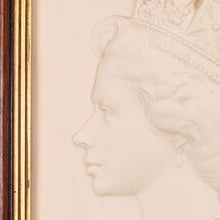Queen Elizabeth II Bas-Relief Portrait, 1977
- Regular price
- £1,100
- Sale price
- £1,100
- Regular price
-
- Unit price
- /per
Adding product to your cart
Overall: 60cm (24in) x 48cm (19in)
Silver Jubilee portrait relief by Arnold Machin, No. 117/1000. Produced by Royal Worcester in porcelain. Contained in original frame.
Arnold Machin, OBE, RA (1911–1999) was apprenticed as a painter at the Minton Pottery in the 1930s and learnt to sculpt at Stoke-on-Trent Art School. He was imprisoned during the Second World War for his beliefs as a conscientious objector. In 1946 he was elected an associate member of the Royal Academy, whence he was appointed a Master of Sculpture from 1959 to 1966 and became the longest-serving member of the Academy. He was elected an Academician in 1956 and a Fellow of the Royal Society of British Sculptors. From 1951 he was a tutor at the Royal College of Art.
In 1964 Machin was chosen to design a new effigy of the Queen for the decimal coinage, which was to be introduced from 1968. This effigy was used for all British coins until 1984. It was still on coins of New Zealand and Australia until 1985 and 1986 respectively, and it remained on Canada’s coinage until 1989. In 1966 the Queen approved Machin's similar design for an effigy of her to be used on what come to be known as the Machin Series of British definitive postage stamps. Machin produced a bas-relief in clay, which when combined with a different coloured background, is reminiscent of the overlaid decoration of potteries such as Wedgewood. The design was first used on the 4d value which was issued in June 1967, and has been used on all British definitive stamps (except more recent regional issues) ever since. It is thought that this design is the most reproduced work of art in history with approximately 320 billion copies produced.










